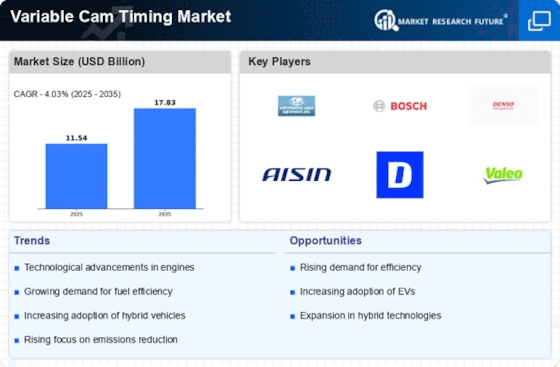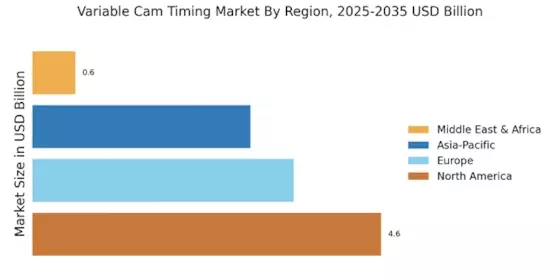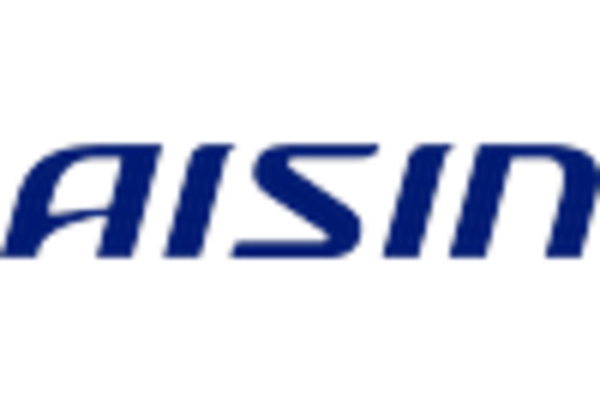Rising Demand for Fuel Efficiency
The Variable Cam Timing Market is witnessing a rising demand for fuel efficiency among consumers and manufacturers alike. As fuel prices fluctuate, there is an increasing emphasis on technologies that enhance fuel economy. Variable cam timing systems are recognized for their ability to optimize engine performance, thereby improving fuel efficiency. In 2025, the market is projected to grow as consumers prioritize vehicles that offer better mileage and lower operational costs. This trend is further supported by manufacturers who are integrating variable cam timing technologies into their engine designs to meet consumer expectations. The focus on fuel efficiency is likely to drive innovation and investment in the Variable Cam Timing Market, fostering a competitive landscape.
Growth of Electric and Hybrid Vehicles
The Variable Cam Timing Market is also influenced by the growth of electric and hybrid vehicles. As the automotive industry shifts towards electrification, there is a growing need for advanced engine technologies that can complement electric powertrains. Variable cam timing systems are being integrated into hybrid vehicles to optimize the performance of internal combustion engines, enhancing overall efficiency. In 2025, the market is projected to expand as manufacturers develop hybrid models that leverage variable cam timing technologies. This integration not only improves fuel efficiency but also contributes to reduced emissions, aligning with the industry's sustainability goals. The rise of electric and hybrid vehicles is likely to create new opportunities within the Variable Cam Timing Market, fostering innovation and development.
Technological Advancements in Engine Design
The Variable Cam Timing Market is experiencing a surge due to rapid technological advancements in engine design. Innovations such as advanced electronic control units and precision manufacturing techniques are enhancing the performance and efficiency of variable cam timing systems. These advancements allow for better fuel economy and reduced emissions, aligning with regulatory standards. The market is projected to grow as manufacturers increasingly adopt these technologies to meet consumer expectations for high-performance vehicles. In 2025, the market is expected to reach a valuation of approximately USD 5 billion, driven by the integration of smart technologies in automotive engines. This trend indicates a shift towards more sophisticated engine management systems, which are essential for optimizing performance and efficiency.
Regulatory Compliance and Emission Standards
The Variable Cam Timing Market is significantly influenced by stringent regulatory compliance and emission standards imposed by various governments. As environmental concerns escalate, regulations are becoming more rigorous, compelling automotive manufacturers to adopt technologies that reduce emissions. Variable cam timing systems play a crucial role in achieving these objectives by optimizing engine performance and minimizing fuel consumption. In 2025, it is anticipated that the market will expand as manufacturers strive to comply with these regulations, which are expected to become even more stringent. This compliance not only enhances the market for variable cam timing systems but also drives innovation in engine technologies, ensuring that vehicles meet the evolving standards for sustainability.
Consumer Preference for High-Performance Vehicles
The Variable Cam Timing Market is significantly shaped by consumer preferences for high-performance vehicles. As automotive enthusiasts seek enhanced driving experiences, manufacturers are increasingly incorporating variable cam timing systems into their engine designs. These systems allow for improved throttle response and power delivery, which are critical for performance-oriented vehicles. In 2025, the market is expected to benefit from this trend, as more consumers opt for vehicles that offer superior performance characteristics. This shift in consumer behavior is likely to encourage manufacturers to invest in advanced variable cam timing technologies, thereby driving market growth. The demand for high-performance vehicles is anticipated to remain strong, further propelling the Variable Cam Timing Market.


















Leave a Comment